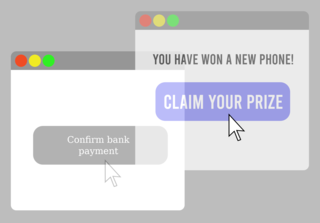
JavaScript, often abbreviated as JS, is a programming language and core technology of the Web, alongside HTML and CSS. 99% of websites use JavaScript on the client side for webpage behavior.

Netscape Navigator is a discontinued proprietary web browser, and the original browser of the Netscape line, from versions 1 to 4.08, and 9.x. It was the flagship product of the Netscape Communications Corp and was the dominant web browser in terms of usage share in the 1990s, but by around 2003 its user base had all but disappeared. This was partly because the Netscape Corporation did not sustain Netscape Navigator's technical innovation in the late 1990s.

The World Wide Web is an information system that enables content sharing over the Internet through user-friendly ways meant to appeal to users beyond IT specialists and hobbyists. It allows documents and other web resources to be accessed over the Internet according to specific rules of the Hypertext Transfer Protocol (HTTP).

A bookmarklet is a bookmark stored in a web browser that contains JavaScript commands that add new features to the browser. They are stored as the URL of a bookmark in a web browser or as a hyperlink on a web page. Bookmarklets are usually small snippets of JavaScript executed when user clicks on them. When clicked, bookmarklets can perform a wide variety of operations, such as running a search query from selected text or extracting data from a table.
Cross-site scripting (XSS) is a type of security vulnerability that can be found in some web applications. XSS attacks enable attackers to inject client-side scripts into web pages viewed by other users. A cross-site scripting vulnerability may be used by attackers to bypass access controls such as the same-origin policy. During the second half of 2007, XSSed documented 11,253 site-specific cross-site vulnerabilities, compared to 2,134 "traditional" vulnerabilities documented by Symantec. XSS effects vary in range from petty nuisance to significant security risk, depending on the sensitivity of the data handled by the vulnerable site and the nature of any security mitigation implemented by the site's owner network.
URL redirection, also called URL forwarding, is a World Wide Web technique for making a web page available under more than one URL address. When a web browser attempts to open a URL that has been redirected, a page with a different URL is opened. Similarly, domain redirection or domain forwarding is when all pages in a URL domain are redirected to a different domain, as when wikipedia.com and wikipedia.net are automatically redirected to wikipedia.org.
The Web Proxy Auto-Discovery (WPAD) Protocol is a method used by clients to locate the URL of a configuration file using DHCP and/or DNS discovery methods. Once detection and download of the configuration file is complete, it can be executed to determine the proxy for a specified URL.
This is a comparison of both historical and current web browsers based on developer, engine, platform(s), releases, license, and cost.

The Mozilla Application Suite is a discontinued cross-platform integrated Internet suite. Its development was initiated by Netscape Communications Corporation, before their acquisition by AOL. It was based on the source code of Netscape Communicator. The development was spearheaded by the Mozilla Organization from 1998 to 2003, and by the Mozilla Foundation from 2003 to 2006.
NoScript is a free and open-source extension for Firefox- and Chromium-based web browsers, written and maintained by Giorgio Maone, a software developer and member of the Mozilla Security Group.

HTTP cookies are small blocks of data created by a web server while a user is browsing a website and placed on the user's computer or other device by the user's web browser. Cookies are placed on the device used to access a website, and more than one cookie may be placed on a user's device during a session.

In HTTP, "Referer" is an optional HTTP header field that identifies the address of the web page, from which the resource has been requested. By checking the referrer, the server providing the new web page can see where the request originated.
JSONP, or JSON-P, is a historical JavaScript technique for requesting data by loading a <script> element, which is an element intended to load ordinary JavaScript. It was proposed by Bob Ippolito in 2005. JSONP enables sharing of data bypassing same-origin policy, which disallows running JavaScript code to read media DOM elements or XMLHttpRequest data fetched from outside the page's originating site. The originating site is indicated by a combination of URI scheme, hostname, and port number.

Clickjacking is a malicious technique of tricking a user into clicking on something different from what the user perceives, thus potentially revealing confidential information or allowing others to take control of their computer while clicking on seemingly innocuous objects, including web pages.
Cross-origin resource sharing (CORS) is a mechanism that allows a web page to access restricted resources from a server on a domain different than the domain that served the web page.
Cross-site request forgery, also known as one-click attack or session riding and abbreviated as CSRF or XSRF, is a type of malicious exploit of a website or web application where unauthorized commands are submitted from a user that the web application trusts. There are many ways in which a malicious website can transmit such commands; specially-crafted image tags, hidden forms, and JavaScript fetch or XMLHttpRequests, for example, can all work without the user's interaction or even knowledge. Unlike cross-site scripting (XSS), which exploits the trust a user has for a particular site, CSRF exploits the trust that a site has in a user's browser. In a CSRF attack, an innocent end user is tricked by an attacker into submitting a web request that they did not intend. This may cause actions to be performed on the website that can include inadvertent client or server data leakage, change of session state, or manipulation of an end user's account.
Web Messaging, or cross-document messaging, is an API introduced in the WHATWG HTML5 draft specification, allowing documents to communicate with one another across different origins, or source domains while rendered in a web browser. Prior to HTML5, web browsers disallowed cross-site scripting, to protect against security attacks. This practice barred communication between non-hostile pages as well, making document interaction of any kind difficult. Cross-document messaging allows scripts to interact across these boundaries, while providing a rudimentary level of security.
Content Security Policy (CSP) is a computer security standard introduced to prevent cross-site scripting (XSS), clickjacking and other code injection attacks resulting from execution of malicious content in the trusted web page context. It is a Candidate Recommendation of the W3C working group on Web Application Security, widely supported by modern web browsers. CSP provides a standard method for website owners to declare approved origins of content that browsers should be allowed to load on that website—covered types are JavaScript, CSS, HTML frames, web workers, fonts, images, embeddable objects such as Java applets, ActiveX, audio and video files, and other HTML5 features.
Cross-site leaks, also known as XS-leaks, are a class of attacks used to access a user's sensitive information on another website. It is a term found in internet security. Cross-site leaks allow an attacker to access a user's interactions with other websites. This can contain sensitive information. Web browsers normally stop other websites from seeing this information. This is enforced through a set of rules called the same-origin policy. Attackers can sometimes get around these rules, using a "cross-site leak". Attacks using a cross-site leak are often initiated by enticing users to visit the attacker's website. Upon visiting, the attacker uses malicious code on their website to interact with another website. This can be used by a attacker to learn about the user's previous actions on the other website. The information from this attack can uniquely identify the user to the attacker.
History sniffing is a class of web vulnerabilities and attacks that allow a website to track a user's web browsing history activities by recording which websites a user has visited and which the user has not. This is done by leveraging long-standing information leakage issues inherent to the design of the web platform, one of the most well-known of which includes detecting CSS attribute changes in links that the user has already visited.






